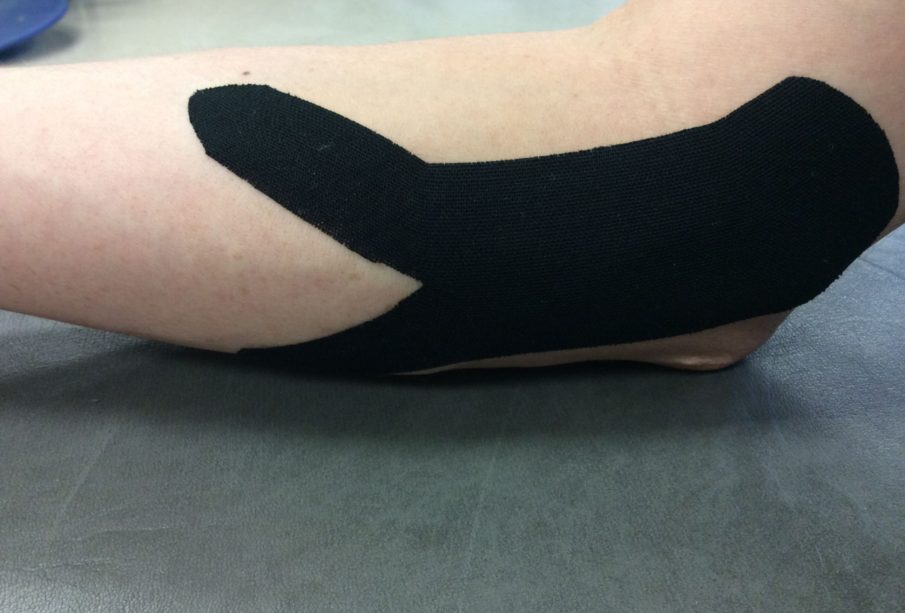Using Kinesiology Tape To Reduce Injury And Improve Recovery

Kinesiology tape has been making waves ever since the 2012 Olympic games in London, where pro athletes were seen donning the colourful strips all over their bodies. Many experts are not in agreement of whether or not the tape actually helps to prevent injury, and this causes the controversy involved in its use. Despite this, many athletes praise the tape for helping them and claim that it has medical benefits.
Aside from being a flashy fashion statement, how does kinesiology tape help to reduce injuries and help improve recovery?
A little kinesiology tape history lesson is required in order to further understand kinesiology tape’s role in the sports industry.
Kinesiology tape was invented by a Japanese chiropractor by the name of Kenzo Kase back in the 1970s. Kase invented the tape to fill a gap in treatment options available at the time. He was in search of a treatment option that facilitated “the body’s natural healing process and [prolonged] the benefits of his treatment after patients left his clinic.” Using his knowledge as a practicing chiropractor, Kase was able to develop this new method in treating internal pain and dysfunction via kinesiology tape.
After its development, the tape sparked interest within the health community, and not long after that, Kase was asked to share his findings and information so that other practitioners could do the same for their patients. Then, in 1983, kinesiology tape was made widely available to the public. And it is not long after this that national sports teams started using the tape. Eventually, it was seen during the Olympics and this exposure causes even more controversy surrounding the tape.
Kinesiology tape is used in a rehabilitative way, which is designed to help the body heal naturally while providing it with support and stability for the muscles and joints without restriction, unlike other treatments, like braces. Kinesiology tape allows a wide range of motion to the body, allowing athletes to continue to do what they love. Not only does kinesiology tape offer a therapeutic treatment, but it will give your patient support when they need to rehabilitate an injury as well.
How Does Kinesiology Tape Prevent Injuries?
Kinesiology tape can be applied to an athlete’s weak areas, or areas that are weaker than others, in order to prevent injury. How does it do that? If you lead an active lifestyle, you’ll know that there are risks of injuries and sprains involved if you so much take a single misstep. That, and extended wear and tear of muscles and joints, will eventually cause an injury.
This is where the preventative characteristics of kinesiology tape can be useful. You can apply kinesiology tape to weakened joints in order to help you prevent injuries. You can use it to control an ankle, stabilize your shoulder or protect a ligament. So the next time you’re gearing up for a big sporting event, or you are just going through your daily physical activities, you can use specific kinesiology taping techniques to help you protect yourself.
When applied correctly, kinesiology tape will lift your skin and create a small space between your muscles and connective tissues, which will increase blood flow and allow easier lymphatic drainage. This will take the pressure off of joints that are swelling and allows for effective muscle movement.
The key is knowing how and where to apply kinesiology tape properly. If applied improperly or in the wrong areas, it won’t help in injury prevention or recovery. There are many video tutorials on the internet where you can see examples of how to apply and use kinesiology tape for a variety of different problems and problem areas. Each video will detail how to correctly use the kinesiology tape on your body. If you are planning to use kinesiology tape for prevention, it helps greatly to ask an expert. You should talk to your physical therapist about taping methods and areas. They can even advise you on where to place the tape, depending on your specific problem areas and issues. But if you find yourself relying on kinesiology tape for long periods for support, you should most likely get checked by your doctor to see if there is any long term damage being done.
How Can Kinesiology Tape Be Used For Injury Recovery?
The second thing kinesiology is great for is as a treatment or supplementary treatment for injury recovery. If you’re experiencing pain or injury, the first step should be to see a medical professional; either a physical therapist, a chiropractor or practicing medical doctor. Kinesiology tape shouldn’t only be the only treatment you are undergoing and be wary of any doctors who recommend it as such. It does well as a component in a recovery program. It should be used as a tool and not a cure.
Proper diagnosis is the first step in the recovery process. Without that, you’ll just be shooting in the dark, and kinesiology tape will not be able to help you. Your doctor can help you with determining where your injury is and what kind of injury it is. After discovering this, the use of kinesiology tape becomes beneficial. Kinesiology tape acts like a support system for your muscles and joints during recovery. While you build up your strength, kinesiology tape will help to hold your joints in proper alignment and help you with facilitating blood flow to the site of injury. This is essential to healing quickly.
Kinesiology tape can help you make a speedy recovery from almost any type of injury. When using kinesiology tape, you will be able to perform at the same level, or even better. Of course, your recovery period will vary, depending on how severe your injury is, where it is located on the body, and if that location can be taped effectively. Again, be sure to check with your medical practitioner to be positive that you are applying the tape correctly!
Kinesiology tape can be used as a great, cost-effective solution for the prevention of injury or recovery of injury. It can be customized to suit your style, and is an all-around useful tool for athletes everywhere. It can also be used in conjunction with a variety of other medical treatments for injury or any long term conditions you might be suffering from.
Author’s bio
Rhett Desormeaux is a content writer currently working with BreezeMaxWeb. He’s a passionate writer and loves studying ancient history, especially Bronze Age civilizations.
Types Of Physiotherapy Treatments Used
January 18, 2025Why You Should Be Eating More Guava Fruit
January 25, 2023
Leave a reply Cancel reply
You must be logged in to post a comment.
-
Total Guide to Velo Nicotine Pouches
January 18, 2021 -
Home Remedies and Natural Treatment Of Shingles
February 22, 2019 -
Five Reasons to Have Your Wisdom Teeth Pulled
March 17, 2021





